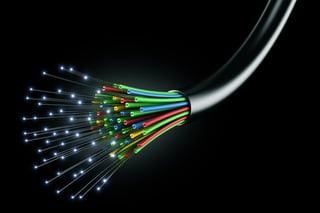 Optical fiber is made by drawing glass or plastic to a desired length and diameter (slightly larger than a human hair). This flexible and highly pure fiber is most commonly used to transmit light for a wide range of applications including visible light displays, sensors, and high-speed communications networks which we will discuss in this article.
Optical fiber is made by drawing glass or plastic to a desired length and diameter (slightly larger than a human hair). This flexible and highly pure fiber is most commonly used to transmit light for a wide range of applications including visible light displays, sensors, and high-speed communications networks which we will discuss in this article.
The Basics of Optical Fiber for High-Speed Communications
Optical fibers and cables have proven to be more reliable than their metal wire counterparts, partially due to the lower rate of loss or interruption of data, but largely in part to their immunity to electromagnetic interference. In addition, optical fiber allows for transmission of data over greater distances with higher bandwidths than earlier wire cable. Other key features of optical fiber are its electrical insulative properties, cost effectiveness, and improved security of the information being transmitted.
In terms of their construction, optical fibers have a transparent "core" which is surrounded by a transparent "cladding" material with a lower index of refraction, which helps to keep light in the core. Due to some leakage of light over a distance, attenuation (or transmission "loss") is a result of the decrease in intensity of the light beam as it travels through the optical fiber. Attenuation is the most important limiting factor in the transmission of light signals (especially over long distances), although dispersion of the light is another factor that affects performance.
Primary Types of Optical Fibers
Over the years, significant research and development has been invested into improving the general performance of fiber. Most are continuously improved upon to further minimize attenuation/loss and dispersion over longer distances and there are many subsets that apply to very specific network and performance standards. However, the two primary categories are single mode and multimode optical fibers.
Single mode optical fibers have a smaller diameter core (9µm) that only allows for one mode of light to propagate. As a result, the amount of light leakage decreases and minimizes the attenuation, allowing the signal to travel longer distances. Typically, single mode fiber is used for distances beyond several hundred meters by telecom and CATV service providers, government agencies, and major enterprises and universities with large campuses and networks.
Multimode optical fibers have a larger diameter core (50µm or 62.5µm) than single mode fibers, which allows for the propagation of multiple modes of light. The amount of light that passes through the core is increased, thus enabling a higher amoutn of information to pass through at any one time. Because of the higher rates of dispersion and attenuation, the signal quality is significantly reduced over longer distances, so multimode fibers are typically deployed for short distance applications within data centers, Local Area Networks (LAN) and other similar networks. Similar to single mode and other communication fibers, subsets of mutimode fiber types exist on the basis of construction/makeup (step-index, graded-index, etc) and for varying bandwidth rates over specific distances (OM2, OM3, OM4).
M2 Optics | Learn More About Optical Fibers
Since there are many standard and specialty optical fibers that exist for use within communications networks, there is not only a vast amount of information that exists about fibers and their specific applications, but also many similarities and differences between types that are important to understand when working with fiber-based systems.
For over 15 years, M2 Optics has been providing custom lengths of optical fiber in professional platforms to many of the world's most recognized companies for network simulation, latency, and system demonstration applications. Contact our experienced team for a free consultation if you have any questions about optical fibers and their use within today's advanced communications networks.






